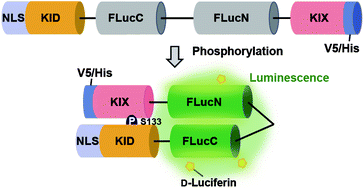Enhanced bioluminescent sensor for longitudinal detection of CREB activation in living cells†
Abstract
Cyclic adenosine monophosphate (cAMP) response element-binding protein (CREB) is associated with memory formation and controls cell survival and proliferation via regulation of downstream gene expression in tumorigenesis. As a transcription factor, CREB binds to cAMP response elements. Phosphorylation of CREB triggers transcriptional activation of CREB downstream genes following the interaction of the kinase-inducible domain (KID) of CREB with the KID interaction domain (KIX) of CREB-binding protein. Nevertheless, because of the lack of single-cell analytical techniques, little is known about spatiotemporal regulation of CREB phosphorylation. To analyze CREB activation in single living cells, we developed genetically encoded bioluminescent sensors using luciferase-fragment complementation: the sensors are designed based on KID–KIX interaction with a single-molecule format. The luminescence intensity of the sensor, designated as CREX (a sensor of CREB activation based on KID(CREB)–KIX interaction), increased by phosphorylation of CREB. Moreover, the luminescence intensity of CREX was sufficient to detect CREB activation in live-cell bioluminescence imaging for single-cell analysis because of the higher sensitivity. CREX sensor is expected to contribute to elucidation of the spatiotemporal regulation of CREB phosphorylation by applying single-cell analysis.



 Please wait while we load your content...
Please wait while we load your content...